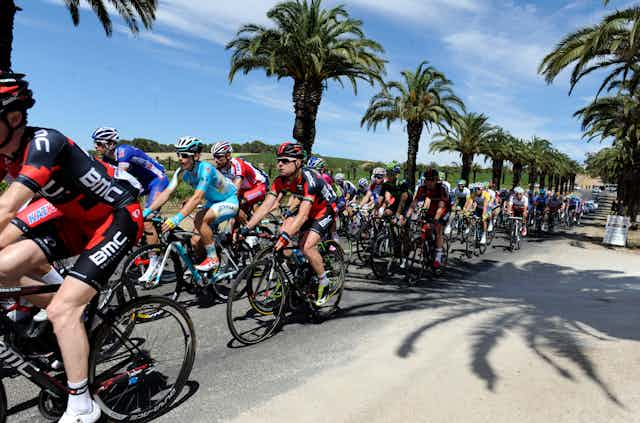Complacency can kill. You would have to be living under a rock to be unaware that heat exposure can be deadly. Yet every year Australia – supposedly the “clever country” – endangers the lives of everyone from elite athletes to construction workers by making them work in the summer heat.
Sports schedulers and workplace regulators urgently need to take off their blinkers and confront our problem with extreme weather.
It is not sensible to schedule the gruelling Tour Down Under for January in Adelaide. Likewise, the Australian Open tennis championship should not be held in Melbourne in January. This year, players have complained about having to play on in temperatures well above 40C.
Yet the vested interest in these major sporting events is massive. Given the involvement of television stations, advertising, flights, hotels, transport, security and the range of support industry staff, there is an understandable reluctance to interrupt meticulous plans. But is that worth the death of, say, one of the world’s top tennis players?
Hot competition
Athletes’ bodies are the tools of their trade. Sporting success and careers are built on fitness. Heat injuries can destroy all that. Competitions in extreme heat become a test of heat tolerance rather than athletic performance and skill. Sports professionals have responsibilities to their fans and their sponsors, so it is very difficult for them to withdraw to protect their health. Event organisers have a duty of care to provide safe environments so the decision should rest with them to modify events in extreme conditions.
About 80% of the energy produced by working muscles is heat, so without heat loss via sweating, we would overheat in about six minutes. High-intensity sports increase physiological heat generation 15-20 fold, and this extra heat must be dissipated to the environment via sweating. The rate of heat exchange on a hot day is poor, and when the air temperature is more than 37 degrees it becomes negligible, generating more heat load than can be dissipated and resulting in heat stress. It can be life-threatening, even for the very fit.
But it is not only elite athletes who are at risk; local club sports and recreational participants and organisers must consider the heat in planning their games. This includes prospects for modifying the activity, to provide shade and cool water, increased rest breaks, and altering the timing. Cricket is played in summer in the heat of the day, and each year players are among those who suffer problems with heat.

Perhaps even more pervasive is workplace heat exposure. Many occupations must be done outdoors, or in buildings that cannot be effectively cooled. Some work can be rescheduled for the evening, but not all. Workers who provide essential services, such as district nurses visiting the elderly, put their own lives at risk on hot days to care for the elderly and unwell. Yet systematic funding cuts call for their increased productivity. Rarely do we see staff numbers being increased to ease their workload.
In the construction industry there are building contracts that factor in “rain delays”. Why are there no official “heat delays”?
My research group at the Australian National University is currently exploring the effects of heat on health and productivity, with the aim of identifying safe working thresholds and developing strategies that help workers to acclimatise. “Heat-proofing” Australian industry will be vital in our increasingly hot summers.
It is baffling that a hot country like Australia does not collect public data on thermal tolerance at the population level. Australia needs seriously to consider heat and how best to manage it safely. The nation cannot afford to shut down over summer, yet killing our workers or tennis players is also not an option.
Setting safety guidelines on the basis of hospitalisations and deaths is too little, too late. These outcomes must be prevented, and collectively we need to start the conversation on heat and institute a culture of heat safety.
The heat is on
Despite Australia’s long history of hot summers, the evidence is clear that it is getting hotter. Globally, each of the past 13 years (2001 to 2013) have ranked among the 14 warmest on record. The warming trend is not unique to Australia, but have a head start because we were already hot to begin with.
Last year was Australia’s hottest, breaking the previous record set as recently as 2005 by 0.17°C. The Bureau has developed a new heatwave forecasting tool to help people track dangerously hot weather.
Hot weather records around the nation are crashing, often by unusually large margins, whereas new cold extremes are becoming less frequent. The past is quite different to today, and very different from the future.
A clever country would recognise this.

